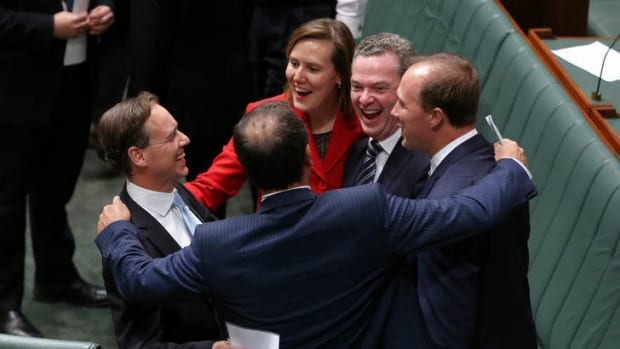Remember the date, July 17, 2014. It is five years ago to the day, when Australia became the first nation in the world to abolish an effective price on carbon emissions.
Australia achieved a world first, but a record that history is unlikely to look kindly upon, captured in the image of federal Coalition government ministers embracing themselves in celebration, having just killed off Australia’s first, and to this date only effective climate policy in an act of political vandalism,
The Abbott-led opposition went into the 2013 election campaign on a platform focused on abolishing the carbon price that the outgoing Gillard government had put in place, with the help of The Greens and with Professor Ross Garnaut as a key advisor.
Having executed a successful scare campaign, which included claims of $100 lamb roasts, and the warning that Whyalla would be a ghost town, and navigating a new Senate that included three Palmer United senators, the carbon price was repealed, after just two years of operation and successful emissions reductions.
Abbott, and then environment minister Greg Hunt, promised Australians that they would save $550 a year upon the repeal of the carbon price. But since that time, wholesale electricity prices have almost doubled compared to what they were under the carbon price, putting extra pressure on households.
And emissions have surged too, and now exceed the levels before the carbon price was in effect, with Australia continuing to languish in a policy vacuum that sees the federal government establishing no clear leadership or direction on emissions reductions or supporting the clean energy transformation happening in the global energy market.
The Government’s own projections show both that overall emissions have been rising and that Australia is not on track to meet even modest emissions reduction targets set by the Government.

During its life, the carbon price proved itself to be an effective mechanism, that accelerated reductions in Australia’s greenhouse gas emissions, incentivising the use of more renewables and less coal, all while having no noticeable impact on growth the Australian economy.
A study completed by ANU researchers Marianna O’Gorman and Frank Jotzo following the carbon price repeal estimated that electricity emissions fell 8.2% while the carbon price was in place. The report estimated that total reductions under the carbon price were as high as 17 million tonnes in 2013, the largest a
During the two years the carbon price was in place, the Australian economy continued to grow. Australia did not see the economic disaster that Abbott and co-claimed would occur. Australian GDP grew by 2.6% each year under the carbon price.
In fact, the Australian economy has been comparatively lethargic since the carbon price’s repeal, according to the Australian Bureau of Statistics, GDP growth in the year to March 2019 was just 1.8%, the lowest level in a decade.
In the five years following the carbon price repeal, emissions have increased, energy costs are higher, and the economy has been sluggish. So what was the point?
Recognising the anniversary, environmental campaigners Friends of the Earth have written to Scott Morrison and Angus Taylor, calling on the Federal Government to re-embrace action on climate change, pointing to commitments that are being made by other countries, including a pledge by the UK to achieve net-zero emissions.
“There is an expectation that countries will increase the level of ambition taken to medium-term emissions reduction goals at the UN Climate Action Summit,” Friends of the Earth Cam Walker wrote.
“Will Australia rise to the occasion with a greater level of ambition or will it be a climate pariah along with Saudi Arabia and the Trump administration?”
The Coalition Government has struggled to articulate any alternative plans for tackling emissions post the scrapping of the carbon price. Three energy ministers; Hunt, Frydenberg and Taylor have conceived of and subsequently disposed of multiple policies that would attempt that reducing emissions.
More often than not, the failure of these policies came at the behest of members of the Coalition’s own ranks, with many coalition MPs preferring to threaten mutiny, than support any meaningful climate change policy.
Thankfully, some remnants of the carbon price package continue to remain in place. The Australian Renewable Energy Agency, and the Clean Energy Finance Corporation have underpinned the progress that has been made in Australia’s clean energy sector, and the Climate Change Authority has helped keep the government accountable.
ARENA can take a significant amount of credit for the emergence of Australia’s large-scale solar sector, and the CEFC has helped shepherd billions in private investment into the market.
The results are reflected in emissions figures, which shows the electricity sector continuing to achieve emissions reductions as more renewables projects come online, while emissions surge across the economy, particularly driven by a ramping up of Australian gas exports.
In May, Australia missed an opportunity to get climate and energy policy back on track.
The next Federal election remains the best chance for a return to meaningful climate policy in Australia.










